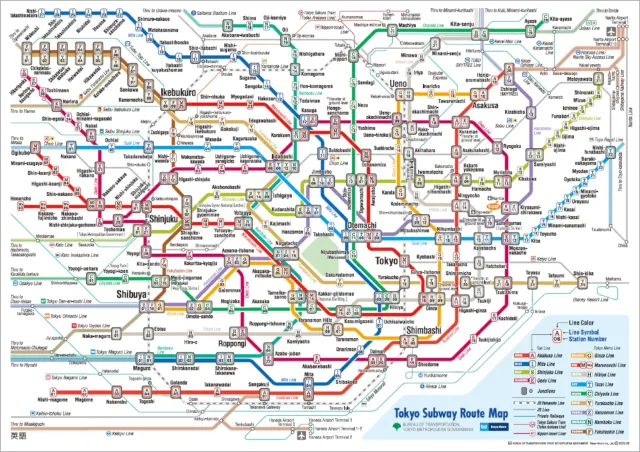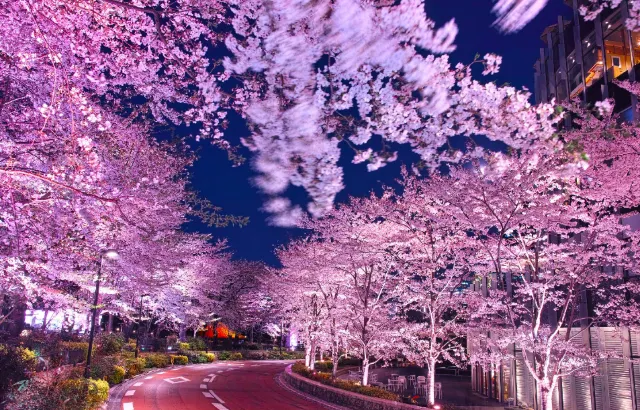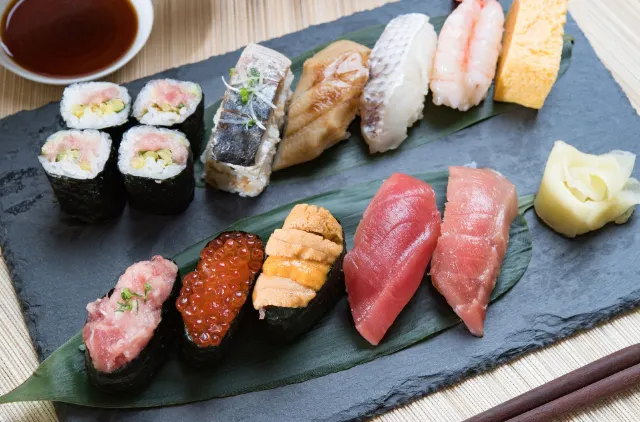Tokyo Travel Guide 2022 - What to Do in Tokyo?
Catalogue
- Things to know if you're visiting Tokyo for the first time
- Tokyo's Airport(s)
- Transportation in Tokyo
- Best Time to Visit Tokyo
- Top Attractions in Tokyo
- Food in Tokyo
- Shopping in Tokyo
- Local Customs in Tokyo, Japan
Show More
The epicenter of sophisticated culture, cutting-edge fashion, futuristic buildings, and all things weird and wonderful, Tokyo is a city of extremes that attracts over 14 million visitors each year, and it should be on your bucket list too.
The capital city of Japan is situated at the Tokyo Bay on the Pacific coast of central Honshu (Japan’s main island). While the Greater Tokyo Area is made up of Tokyo and the three neighboring prefectures, Metropolitan Tokyo consists of 23 wards and municipalities. Tourists are most likely to be residing in central areas like Chiyoda, Minato, Shibuya, Shinjuku, and Taito wards. In addition to being the political and economic center of Japan, Tokyo is also the seat of the Emperor and the imperial family. In terms of population, the Greater Tokyo Area with over 37 million people is the most populous metropolitan area in the world.
Originally named Edo, Tokyo has a long and rich history of over 400 years. The city grew in wealth, power, and size over the centuries with its population reaching over a million by the mid-eighteenth century. The Emperor moved to Edo during Meiji Restoration in 1868, hence renaming the city Tokyo and it became the capital of Japan. With the devastation of earthquakes and war, much of Tokyo was destroyed by the middle of the 20th century. In the 1980s, rapid economic growth and increased global presence transformed Tokyo into one of the world’s economic powerhouses.
Visitors to Tokyo will be attracted to its most famous temples, towers, parks, and shopping streets, but this city with a perfect blend of old and new has so much more to offer. Get into character and go go-karting around town, experience the insanity at the Robot Restaurant, see a Kabuki theatre performance in Ginza, and soak in an Onsen with the locals.
Foodies alert! You’ll be spoiled for choice in Tokyo for authentic local and regional Japanese cuisines, as well as international delights. Be sure to savor delicious culinary creations like tempura, curry rice, sashimi, soba, patisseries, unagi, and sukiyaki.
Not sure what to bring home as a souvenir? Tokyo is world-renowned for being a shopping paradise, visitors can find countless unique local specialty items as gifts and mementos. Consider getting a toy from one of five million vending machines in Japan, top-up on those high-quality Japanese cosmetics, or bring home an omamori lucky charm.
Tokyo is an exciting, energetic, and eccentric megacity that invokes an adrenaline rush. To ensure a smooth and memorable trip, planning is essential if you are a first-time visitor. The peak season of Spring offers comfortable temperatures and amazing natural beauties, e.g. cherry blossoms, but the price and crowd size will dramatically increase too. Visit in the off-season like late Fall or Winter, you’ll get the best deals on hotels and airfares.
Accommodation-wise, consider these popular areas for your stay. If you are looking for Old World Tokyo, staying in the historic neighborhood of Asakusa will put you right next to the famous Sensoji Temple and Ueno Park. For best nightlife, opt for Roppongi and Shinjuku. A good area for families is Odaiba, there are plenty of activities to keep the kiddies entertained.
Ranked as one of the top five most expensive cities in the world, Tokyo can be a little overwhelming, for the wallet that is. Here are some useful tips to help first-time visitors to economize on their trip. From the moment you step off the plane, you can save money by not using the taxi as your transfer option. Choose the Airport Limousine Bus that will take you to many hotels and train stations across Tokyo, fares range from 1,000 to 3,000 yen per ticket. Travel around town, use the extensive public transportation system, the fare for the Tokyo subway starts at 160 yen, and with a Day Pass, you can save even more. The best option to travel around Japan is by train, getting a Japan Rail Pass will save you bundles. Take advantage of free sights and guide service. In Tokyo and other major Japanese cities, many shrines, parks, and markets are free, same goes for volunteer guides who will give free tours to tourists.
Visitors traveling to Tokyo have the option of arriving in two international airports - Narita International Airport (NRT) and Haneda International Airport (HND). Both airports operate international flights from around the globe, are equipped with state-of-the-art facilities, and have easy transfer options to the city.
Situated to the east of central Tokyo, Narita International Airport or Tokyo Narita is 60 km (37 miles) away. As the busiest airport in Japan, it handles over 33 million international passengers each year and is the base for Japan Airlines and All Nippon Airways. All three terminals in Tokyo Narita operate international and domestic flights, with T3 serving mainly low-budget airlines.
To transfer between the NRT and Tokyo city center, first consider the convenient and reasonably priced Airport Limousine Bus. The Limousine buses travel to many of Tokyo’s top hotels and stations, prices are around 3,000 yen for a 90-120 minutes’ journey. Visitors will be informed which bus stop to wait at when buying a ticket at counters outside baggage claim. The fastest method is by JR Narita Express (N’EX), which will take you to Tokyo Station, Ikebukuro, and Shinjuku. Taxi service is also available, but for such a long distance, fares to central Tokyo are around 30,000 yen.
Located 20 km (11 miles) from central Tokyo, Haneda International Airport is a favorite of domestic travelers. But due to its closer proximity to central Tokyo, Haneda is increasingly being used for long-haul flights, especially to the US. There are three terminals with T3 mainly handling international flights. As for transfer options, the Tokyo Monorail will take visitors to Hamamatsucho Station at a cost of 470 yen, the Airport Limousine Bus to Tokyo Station costs 900 yen, and by taxi, the cost is between 6,000-10,000 yen to the city center.
Tokyo, and Japan overall, is renowned for its efficient public transportation networks. Everyday commuters have the choice of traversing the city by electric railways, subways, bus lines, and highways. For visitors, so many options and lines can be confusing. Here is a brief breakdown of each mode of transport.
First of all, no matter which transport system you are using, each has its own fare system and you’ll need a new ticket each time you transfer from one to another, e.g. from the subway to railway. So if you’re not sure what you’ve transferred on to, get yourself a Suica or Pasmo card (sold from ticket vending machines in subway stations). These contactless prepaid cards can be used on almost all modes of transportation, including regular JR trains, private railways, subways, and buses at a discounted price. In addition, if you’ll be traveling a lot each day, consider the Tokyo Combination Ticket (Tokyo Furii Kippu), at a cost of 1,590 yen, you can travel unlimited for 1 day on all modes of transport in the city.
Tokyo subway lines cover the whole city with over 280 stations, but they are not operated by the same company as in most cities. Tokyo Metro provides 9 trains and around 179 stations, while Toei Lines have 106 stations on four lines. If you want a 1-day unlimited travel card for both subway companies, the cost is 900 yen. For only Tokyo Metro company lines, it costs 600 yen.

The main transit hubs for trains and subways in Tokyo are Tokyo Station, Shinagawa, Shibuya, Shinjuku, Ikebukuro, and Ueno stations. These are good places to get on Japan Railways Lines (JR network). While visitors can reach across Japan by rail, in Tokyo, the above-ground Yamanote, and Chūō–Sōbu lines are useful for tourists.
Tokyo has a humid subtropical climate which means mild winters and warm and wet summers. While visitors come to Tokyo year-round, but the best time to explore the city is in Spring (March to May) and Fall (September to November). During these two seasons, the weather is pleasant, and Tokyo is exceptionally beautiful with blossoming flowers in Spring and colorful foliage in Fall. The hottest month is August with an average high temperature of 31C (88F) and the coldest month is January with an average high of 9 C (48 F). If you prefer to holiday in summer and don’t mind the heat, expect short rainfall almost every day and high humidity. There is a rainy season in Tokyo, which typically lasts from early June to mid-July.

There are several peak tourist seasons in Tokyo when visitors should expect large crowds and high prices. First is the end of March to early April when cherry blossoms are in full bloom, then again in the Golden Week (end of April to the first week of May) when a number of holidays mean locals flock to Tokyo and all scenic areas to celebrate. The same is for Fall when crowds gather for the vibrant foliage. Besides the weeks between Christmas and New Year, traveling during the off-season (late autumn through March) can save you a bundle.
Tokyo has a long list of unmissable ancient shrines, manicured gardens, and futuristic architectural gems. For visitors with only a few days in the city, here are three top attractions that should be on everyone’s bucket list.
Asakusa’s ancient Buddhist temple - Sensoji Temple - is the most popular and beautiful destination of the city. Established in AD 645, the temple is rich in exquisite religious structures, such as the Kannondo Hall, Five-Storied Pagoda, and Hozo-mon Gate. That’s why this site is a favorite of culture lovers and religious pilgrims. One of the highlights of the temple complex is the photogenic Kaminari-mon Gate with its massive red paper lantern bearing the inscription “Thunder Gate.” Behind the gate is the crowded and vibrant long street market lined with vendors selling local crafts, souvenirs, and delicious snacks.
Another top sight in Tokyo and a very popular lookout point is the Tokyo Tower. Standing 333 meters high, the impressive red tower is the original icon of Japan's capital. If you are feeling brave, climb 600 steps up the outdoor staircase to the tower's main deck or stand on the glass floor sections to admire the spectacular city below their feet.
When the hustle and bustle of Tokyo get too much, escape to the tranquil and enchanting environment of Ueno Park. Being Tokyo’s largest public park, this expansive and free green space in the Taito district is a great place to relax and immerse in nature. In the Spring, it is also one of the best spots for cherry blossom viewing. In addition to Ueno Park’s stunning setting, it is the home to six museums, historic temples, Ueno Zoo with pandas, and concert halls. For more serene Japanese gardens and parks, check out Shinjuku Gyoen National Garden, Imperial Palace East Garden, and Todoroki Valley.
Japanese food is a diverse cuisine that is rich with regional specialties. While most visitors are familiar with classic foods like sushi or ramen, but there is much more to it than that.
If you thought sushi is Japan’s National Dish, then you’d be wrong. It is in fact curry rice. Introduced to the country in the late 1800 by the British, the Japanese curry is unique in its own way. The hot and spicy curry is typically cooked with meat, potatoes, and carrots resulting in a thick and sticky texture. Visitors can sample curry rice at Chantoya Coconut Curry, Hinoya, and Joto Curry.
Sushi – known locally as Nigiri-sushi - are delicious yet simple creations of raw ingredients like seafood over vinegared rice. While you can sample all kinds of sushi in the capital, but a classic Tokyo style sushi (Edomae-sushi) is a slice of fish atop a mound of rice. Best places to eat fresh sushi include Tsukiji Outer Market, Matsuei, and Kyubei.

Another of Tokyo's most famous foods is tempura, a deep-fried dish consisting of battered seafood, meat, or vegetable. Even for this classic Japanese dish, Tokyo also has its own take, addition of seafood tempuras, e.g. shrimp. A visit to a specialized tempura restaurant is a great way to enjoy a wide variety of this good eat.
Tokyo is world-renowned for being a shopping paradise, and the first place you must visit is the Ginza shopping district. Amongst all of its luxury boutiques and malls, visitors have to stop by the crème de la crème destinations such as Ginza Chuo Dori Street - like Oxford street in London - where visitors can find top Japanese department stores like Matsuya and Mitsukoshi; and experience Ginza’s largest shopping complex Ginza Six with its outstanding range of high-end designer brands and artworks.
While visitors can easily spend days browsing the shops on Ginza, there are several other hot retail destinations in Tokyo to explore, one being the Shinjuku area. From fashion to electronics, Shinjuku has everything you need. For Hello Kitty lovers of all ages, Sanrio Gift Gate Adhoc SHINJUKU is the world's first Sanrio Gift Gate shop, a visit here is a must. For original high-end fashion, Barneys New York Shinjuku is every fashionista’s dream.
Taito City boasts its own diverse array of retail options. For handicrafts and souvenirs, Nishi Sando Shopping Street is located inside a traditional building near the Sensoji Temple. For visitors who prefer to mix shopping with cultural immersion, go explore the quaint little shops in local markets. For example, the popular Mottainai Flea Market in the “Electric Town” of Akihabara.
Tokyo is considered a safe and orderly city for tourists and locals. While the overall risk is low, you’re never completely safe from pickpocketing and petty theft. Visitors are still advisable to take extra precautions, keep an eye on your belongings and beware of your surroundings, especially at night. For the police or to report an accident dial 110, and for fire and ambulance dial 119.
The official currency used in Japan is the Japanese Yen (Yen or ¥). Foreign currencies are only accepted at major international airports. Tipping is not customary in Japan because good service is viewed as the standard, hence tips are unnecessary.
Located in East Asia, Japan is an island nation consisting of five main islands: Hokkaido, Honshu, Shikoku, Kyushu, and Okinawa. The capital city Tokyo is situated on the island of Honshu, which is the largest island and is referred to as the Japanese mainland. In total, there are 47 prefectures and eight traditional regions. With a population of over 126 million people, it is ranked the 11th most populous country in the world. Japan is a constitutional monarchy with a parliamentary government, its imperial family is the oldest continuous hereditary monarchy in the world.
The most commonly spoken language in Japan is Japanese. There are several dialects to the language, including the Tokyo dialect, which is also considered the standard dialect of the country. English is not widely spoken in Japan, so tourists should not expect many locals to speak English when visiting there.
There is only one-time zone in Japan, and it is known as the Japan Standard Time (JST). JST is always 9 hours ahead of Greenwich Mean Time (GMT +9). There are no Daylight-Saving Time clock changes.
Trending Travelogues
Popular Travel Types
Popular Attractions
Popular Ranked Lists
Popular Destinations
Recommended Attractions at Popular Destinations









Site Operator: Trip.com Travel Singapore Pte. Ltd.


